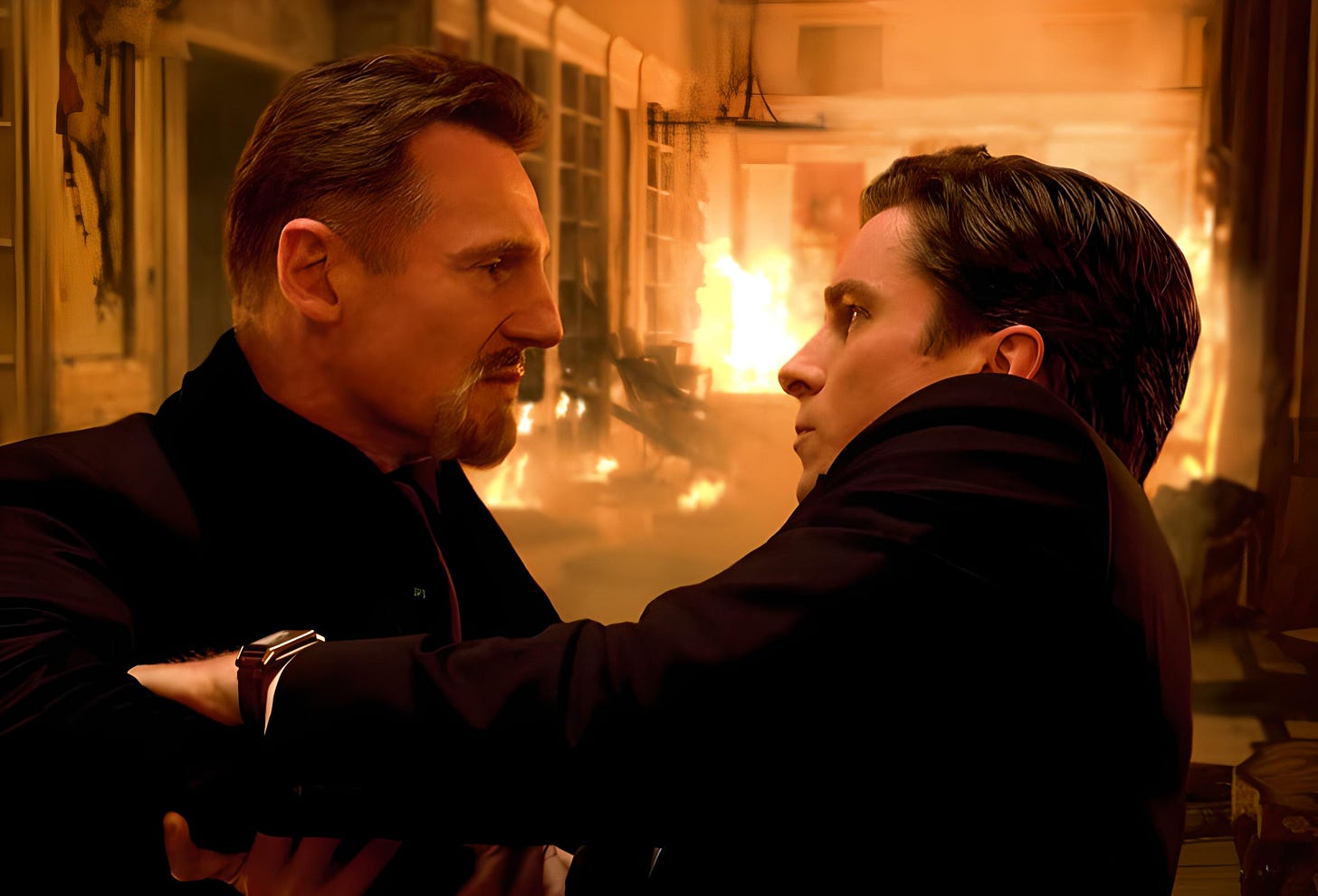“When a forest grows too wild, a purging fire is inevitable and natural."
-Ra’s Al Ghul
There is a communication breakdown between the Old Right and the New Right in American conservatism, and over the past few years, I’ve seen this rift play out repeatedly. More often than not, the fault seems to lie with the Old Right— “Normie Cons” and “Boomer Cons”—who struggle to recognize the New Right as potential allies in the cultural and political battles they face. This disconnect goes beyond simple differences in policy preferences or political strategy; it runs deep into their understanding of the nature of the crisis facing Western civilization and, by extension, the United States.
At its core the divide is a difference in the narratives both sides cling to. Narrative is the most powerful way to communicate ideas, and there’s a reason moral lessons are passed to children through fairy tales and why Christ himself spoke in parables. Stories are the framework through which we understand our world. Recently, while rewatching Batman Begins, I found something familiar in its narrative that explains the fracture within American conservatism—a divide that mirrors the larger societal struggle between clinging to the past and accepting the inevitability of decline and transformation.
In Batman Begins, Bruce Wayne, is dedicated to saving Gotham—a city that has fallen into corruption, lawlessness, and moral decay. Bruce remembers the old Gotham: a city of promise and hope, one his father tirelessly worked to elevate. It was flawed, but it at its heart beautiful. Raised in the lap of luxury, Bruce grew up shielded from Gotham’s underbelly, living within the walls of Wayne Manor, far removed from the crime and poverty that plagued the city’s streets. His father, Thomas Wayne, embodied a kind of noblesse oblige, using his wealth and influence to uplift Gotham’s poor and destitute. However, this honorable cause cost him his life. Thomas Wayne and his wife, Martha, were murdered by a petty criminal during a mugging—an event that young Bruce witnessed firsthand. This trauma left Bruce driven by an unquenchable desire for justice, one rooted in his father's vision of the old Gotham.
Bruce Wayne’s character represents the Old Right. He is deeply connected to the past, just as Boomers and Normie Cons are connected to a pre-Hart-Cellar America, an America before the 1965 Immigration Act fundamentally reshaped the nation's demographics and social fabric. The Old Right looks back fondly on this era and sees it as a time of promise, a time when America was strong, virtuous, and culturally unified. They long for a return to this idealized past, where the dreams of their fathers—dreams of fighting for freedom and democracy at places like Normandy and Iwo Jima—are realized. They believe that by restoring the values of the past, the America they once knew can be reborn.
But just as Thomas Wayne was killed by the very city he sought to save, the Old Right's forebears gave their all, only to see their names tarnished and their legacies defiled. The once-celebrated achievements of their generation are now viewed through the lens of modern cultural critiques, they are labeled as oppressors and bigots. The Old Right’s dream of reviving their father’s America, of recapturing the spirit of an America that no longer exists, is a dream that seems increasingly unattainable, yet one they desperately cling to.
On the other side of this divide stands Ra’s Al Ghul, the leader of the League of Shadows. Ra’s is a man with a deep understanding of history and a commitment to ancient traditions. The League of Shadows, under his leadership, views Gotham’s decay not as a tragedy, but as an inevitable phase in the life of a civilization. To Ra’s, Gotham cannot be saved; it is beyond redemption. The city must die so that something new can take its place. There is no hope in trying to revive a corpse.
Ra’s represents the perspective of the New Right—especially those influenced by thinkers like Nick Land and the adherents of accelerationism. Like Ra’s, they argue that societal decline is not only inevitable but necessary. They believe that Western civilization has entered a phase of irreversible decay, and any attempt to reverse or slow this process is futile. For them, the Old Right's dream of restoring a pre-1960s America is an illusion, a denial of the deep structural changes that have taken place. In their view, the rot runs too deep, and the best course of action is not to save the dying system but to let it collapse, to accelerate its demise so that something new—something stronger—can rise from the ashes.
Ra’s Al Ghul seeks to be an active participant in ushering in a new world, while the accelerationists of the new right generally embrace a passive role viewing decline as part of a natural cycle in the life of civilizations. Spengler’s theory of cyclical history is a touchstone for many on the New Right. In magnum opus The Decline of the West, Spengler shows that civilizations follow a predictable pattern of birth, growth, decline, and death. According to Spengler, the West is in its late-stage decline—what he calls the “winter” phase of its life cycle. To the New Right, this is not something to be mourned; it is simply the way of the world. Attempts to forestall this decline, to hold onto a golden age that has long passed, are not only doomed to fail but will also prolong the suffering of the people caught within the decaying system.
This is why Ra’s and the League of Shadows see Bruce Wayne as a potential ally. They believe that if they can show him the futility of his struggle, they can bring him into their fold. For Ra’s, Bruce is blinded by his loyalty to a dying cause, trapped by his father’s legacy and the desire to continue a mission that can no longer succeed. Bruce, however, sees Ra’s as an enemy, a villain who threatens to destroy the city he loves. He cannot recognize that Gotham, the city he is fighting for, is itself the enemy. Gotham’s corruption is so deep, so systemic, that it cannot be redeemed—but Bruce, driven by idealism and guilt, refuses to accept this. He is trapped in a sunken cost fallacy, determined to fight for something that no longer exists, something that is doomed to fail.
The Old Right finds itself in a similar position as Bruce Wayne. They cannot accept that the America of their youth is gone. The post-war era they remember, the period of prosperity and social cohesion that fuels their nostalgia, was built on foundations that no longer exist. Worse, the very ideas they hold dear—liberalism, individualism, and egalitarianism—are the causes of their civilization’s decline. The Old Right clings to the belief that these values can be restored, that America can once again become the beacon of freedom and democracy they believe it was. But to the New Right, this is a delusion. Liberal egalitarianism is not the solution but the disease. It has eroded the very cultural and moral foundations that once made Western civilization strong, and nothing can reverse the damage.
The New Right has no such illusions. The period of prosperity and stability that the Old Right longs for was never known by the younger generation. They have only seen the slow, steady decline—decade after decade, policy after policy—chipping away at the values and institutions that once held society together. Like Ra’s Al Ghul, the New Right recognizes the inevitability of decline and understands that something new must take its place. To them, Spengler’s vision of cyclical history is not a tragedy but a reality to be accepted and embraced.
In the end, Batman chooses to fight for Gotham, even as the city’s decay continues. He is willing to facilitate the decline, driven by an ideology that will ultimately tear him down just as it destroyed his father. He would rather prolong Gotham’s suffering than accept the reality of its inevitable collapse. Similarly, the Old Right remains committed to fighting for a vision of America that no longer exists, unwilling to acknowledge the depth of the crisis or the need for a new path forward.
The divide between the Old Right and the New Right is not simply one of strategy or policy; it is a divide between two fundamentally different worldviews—one that seeks to resurrect the past, and another that accepts the inevitability of its end and the birth of something new.
-TJS







There's alot I could get into, but I'd rather not rehash -- many others have commented on open borders, trans, anti-white racism, inflation, debt, creeping totalitarianism, the competency crisis, and so on. Suffice to say that the symptoms of decline all around us are tied to root causes that are too far gone to be fixed. Thus, I've accepted the inevitable Fall of the West. Our energy is best directed towards building the next society; to man the lifeboats instead of bailing out the Titanic.